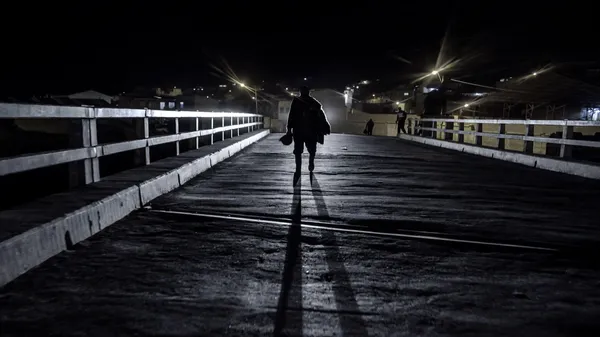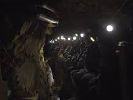Eye For Film >> Movies >> Dark Skull (2016) Film Review
Dark Skull
Reviewed by: Amber Wilkinson

Hearing the set-up for Kiro Russo's Dark Skull - a Bolivian mining community drama using non-professional actors - the expectation would be for a documentary style slice of grim reality. But although the life of the miners is shown to be a hard one, Russo's approach is much more impressionistic than you might imagine, seeking to retain an air of mystery even though he takes a largely neo-realist approach.
The story, co-written by Russo with Gilmar Gonzales, loosely follows anti-hero Elder Manami (Julio Cezar Ticona), a young ne'er do well who is chiefly concerned with where his next drink is coming from. When his father dies and he finds himself on the wrong end of a beating in the city, he returns to his home village, where his uncle helps him to slot into his father's old place in the mine. The story is less important than the routines and moods of the miners. Russo has an interest in light and dark, often capturing long tunnels with light dwindling at the end of them - a technique he uses right from the start of the film as Elder scoots down a dark alley.

Russo's also often narrows the frame using doorways, giving a sense of additional confinement even outside of the mine. Down in the depths itself, the men's rituals are revealed, from the union organising to strong sense of comradeship - a finely balanced system that Elder threatens to disrupt. Russo, benefiting from excellent camerawork from Pablo Paniagua, finds a harsh beauty in the underground caverns of the mine. In one scene, filled with overlaid images, evocative of Sergei Eisenstein, we see its, noisy violent machinery at work. This scene, like several others in the film, also makes you aware of just how many 'shades' of black there are.
Although visually strong, the acting side of things is less successful, perhaps inevitably given that the cast are, for the most part, miners themselves and were fitting in the shooting schedule round their actual daily turns down the shaft. Their mouths are also almost permanently filled to hamster proportions with what appears to be coca leaves, which while indicative of steps taken to relieve some of the drudge of the mine, further hampers the dialogue. If there are weaknesses in the story, however, Russo captures the multi-faceted reality of the mine with verve and his debut feature shows he isn't afraid to take risks or experiment with framing and visuals - boding well for future work.
Reviewed on: 02 Dec 2016















